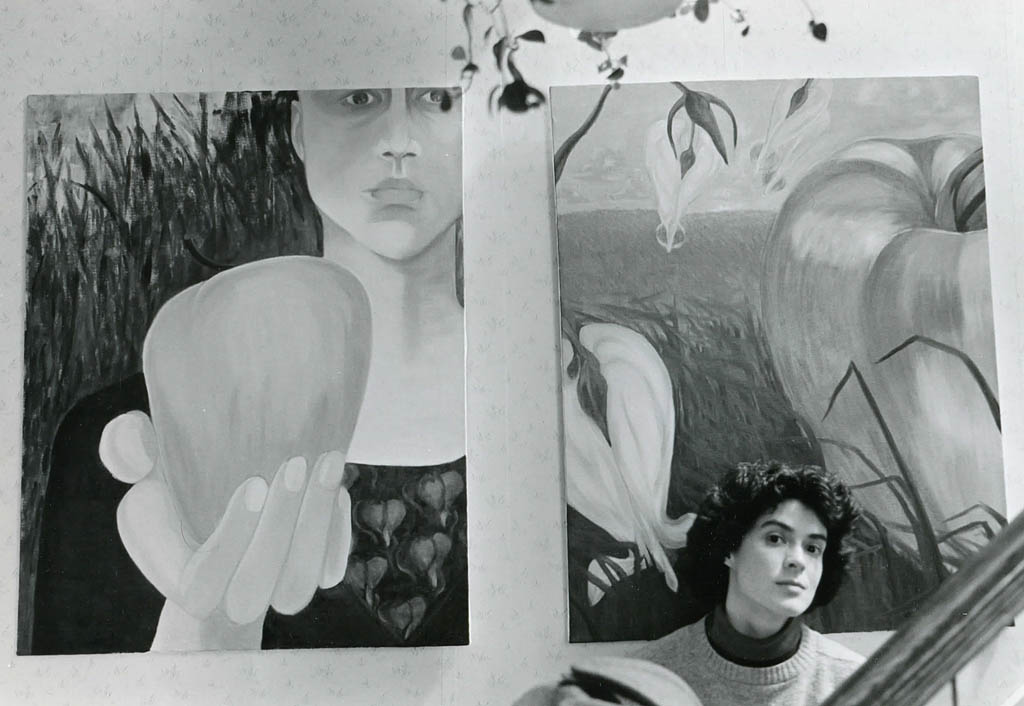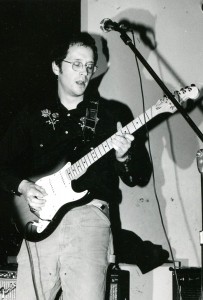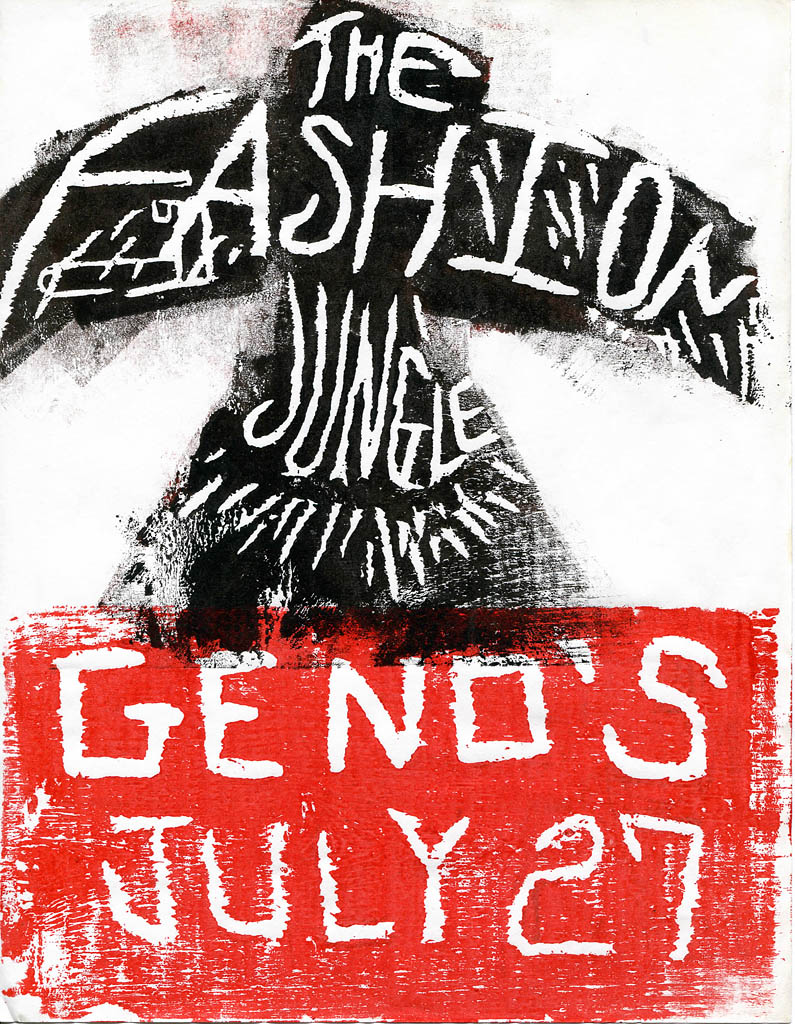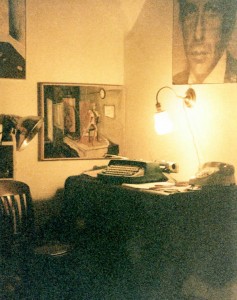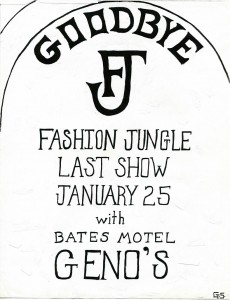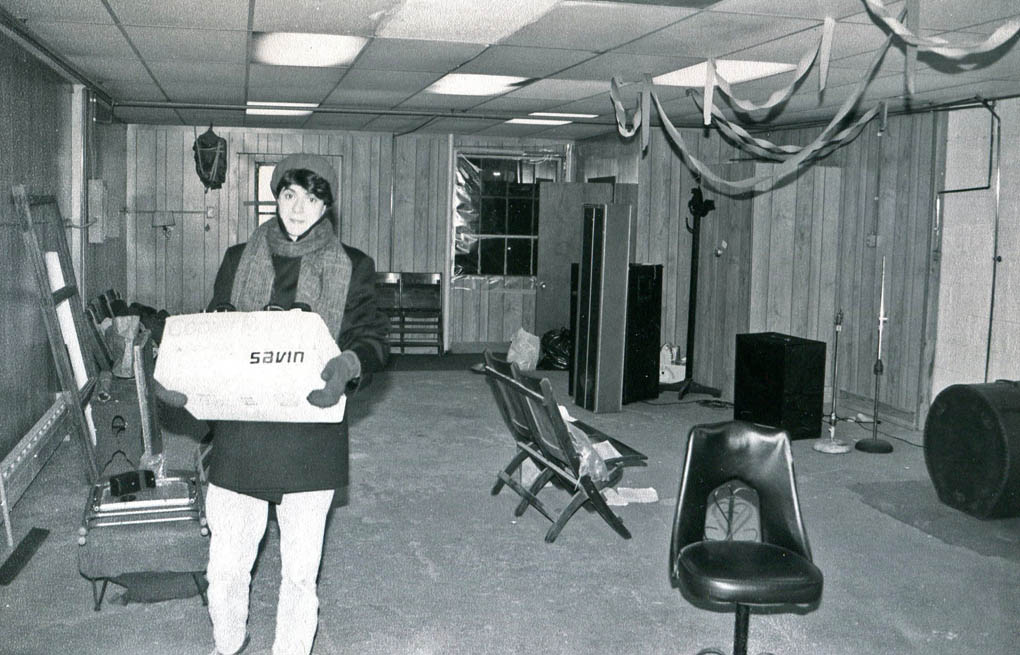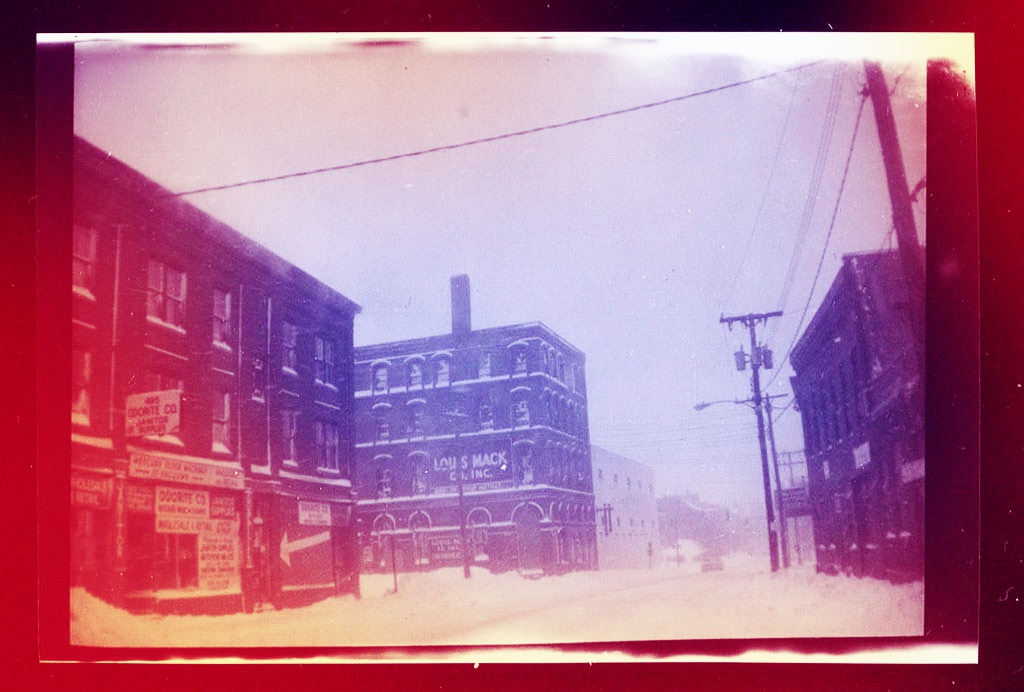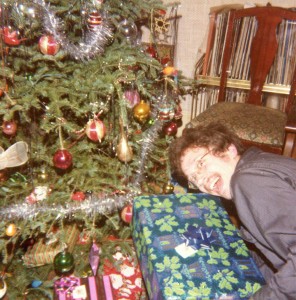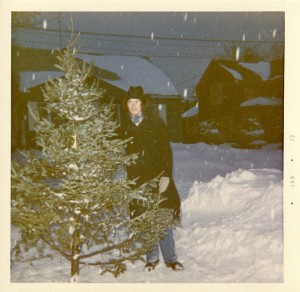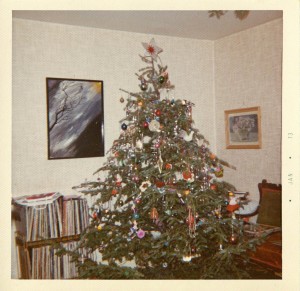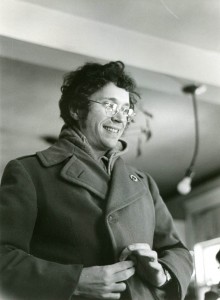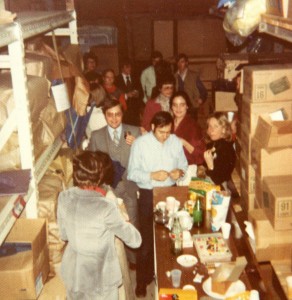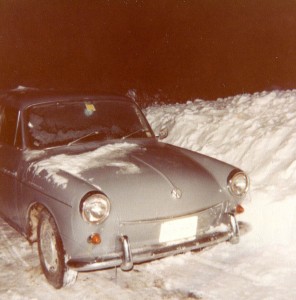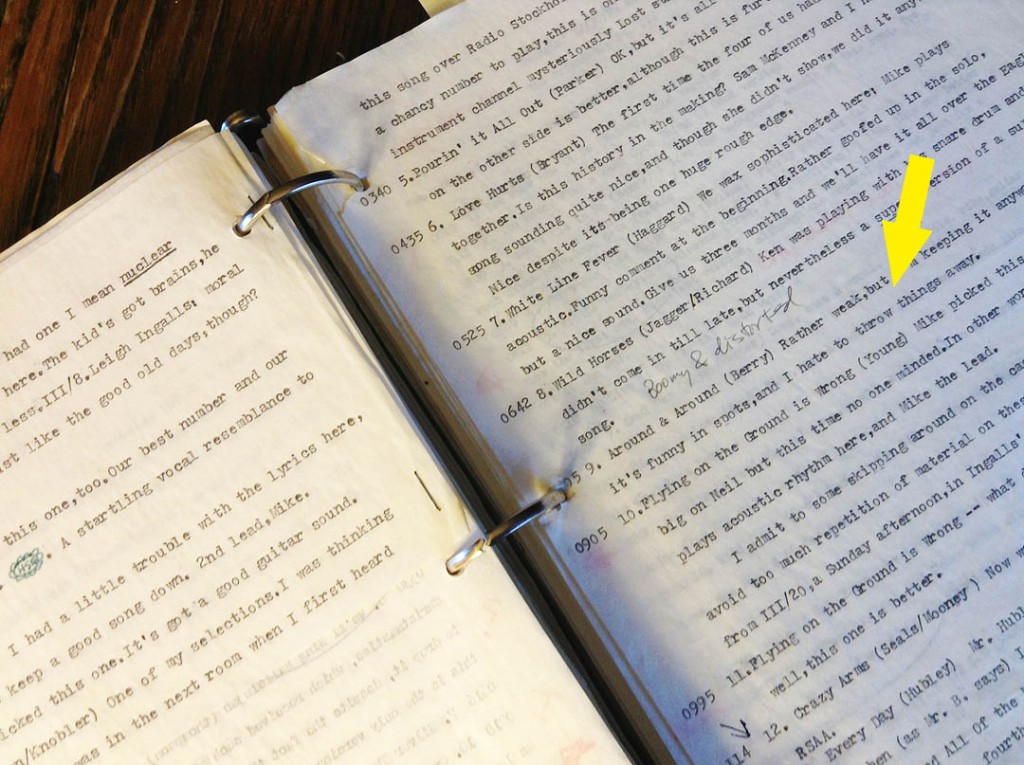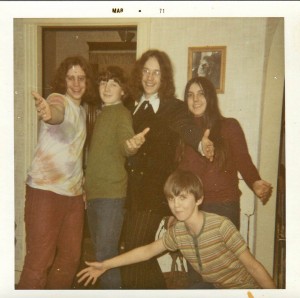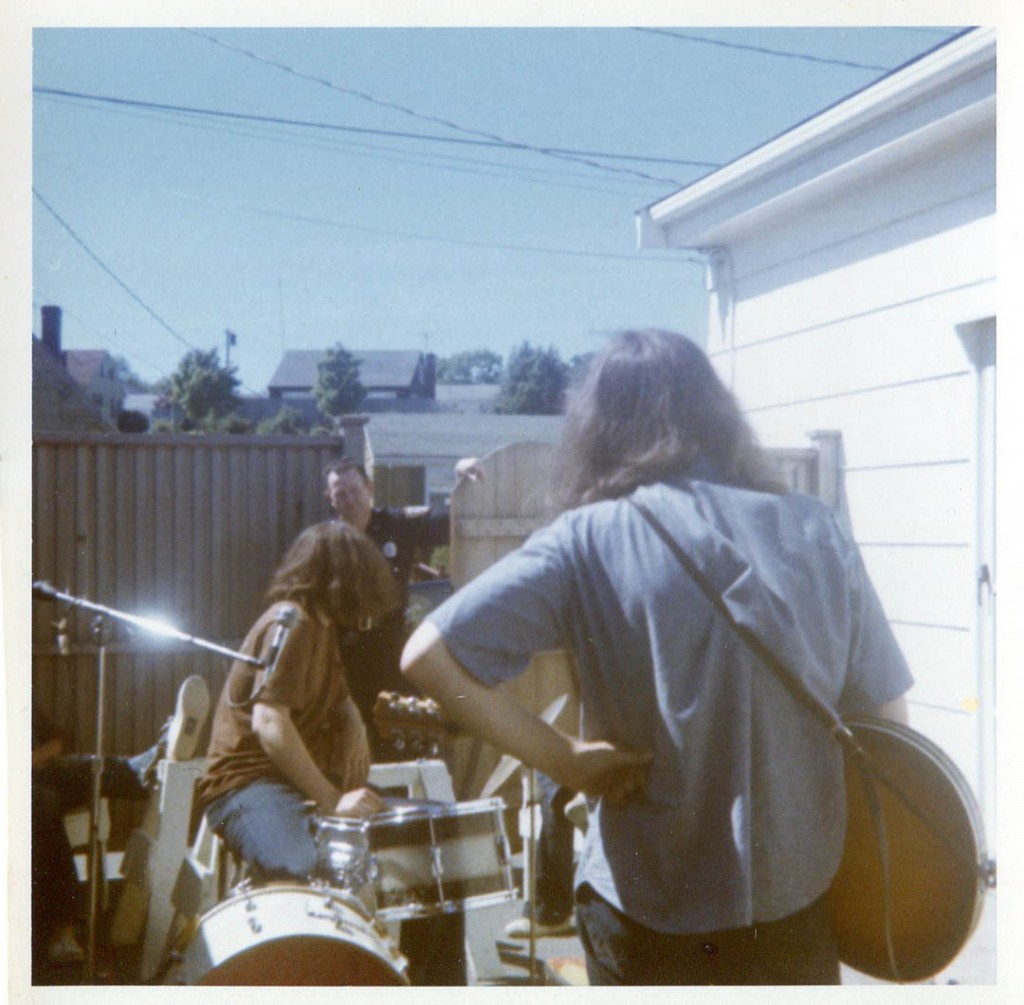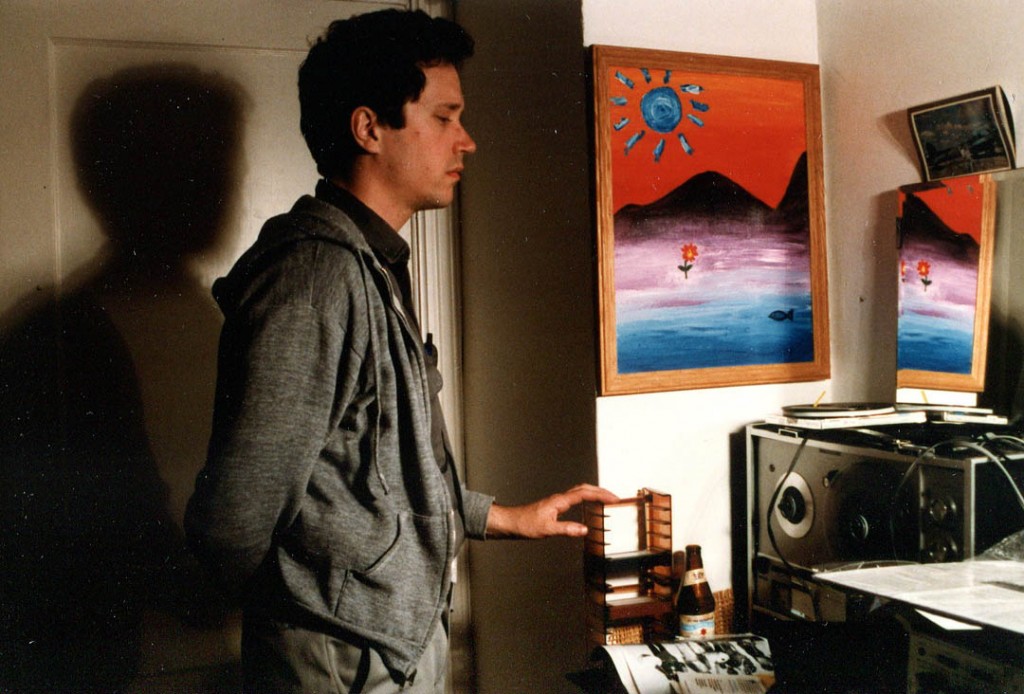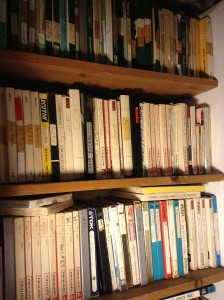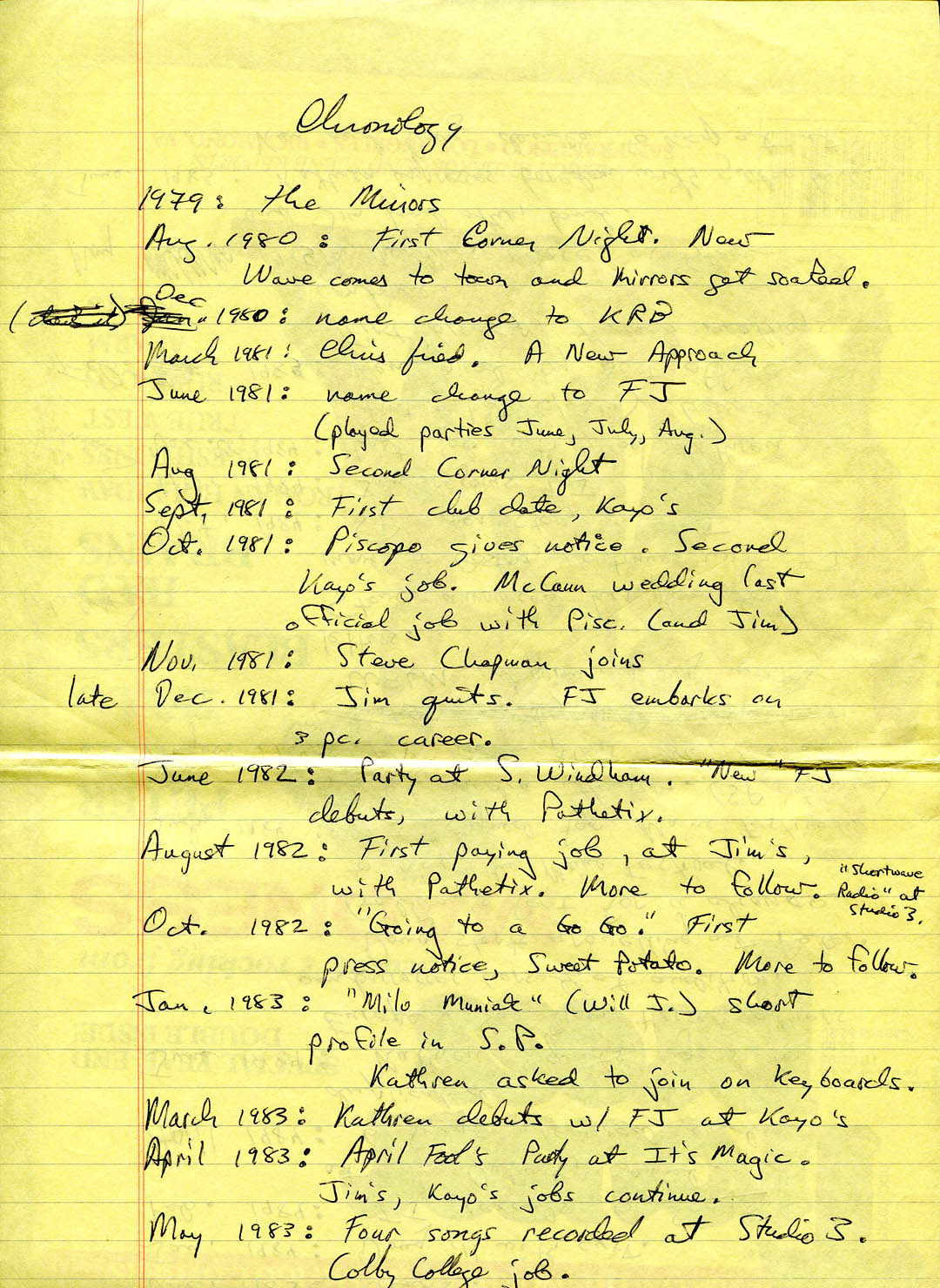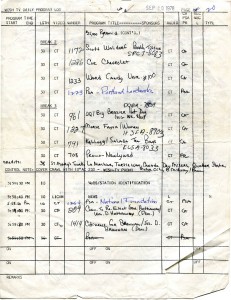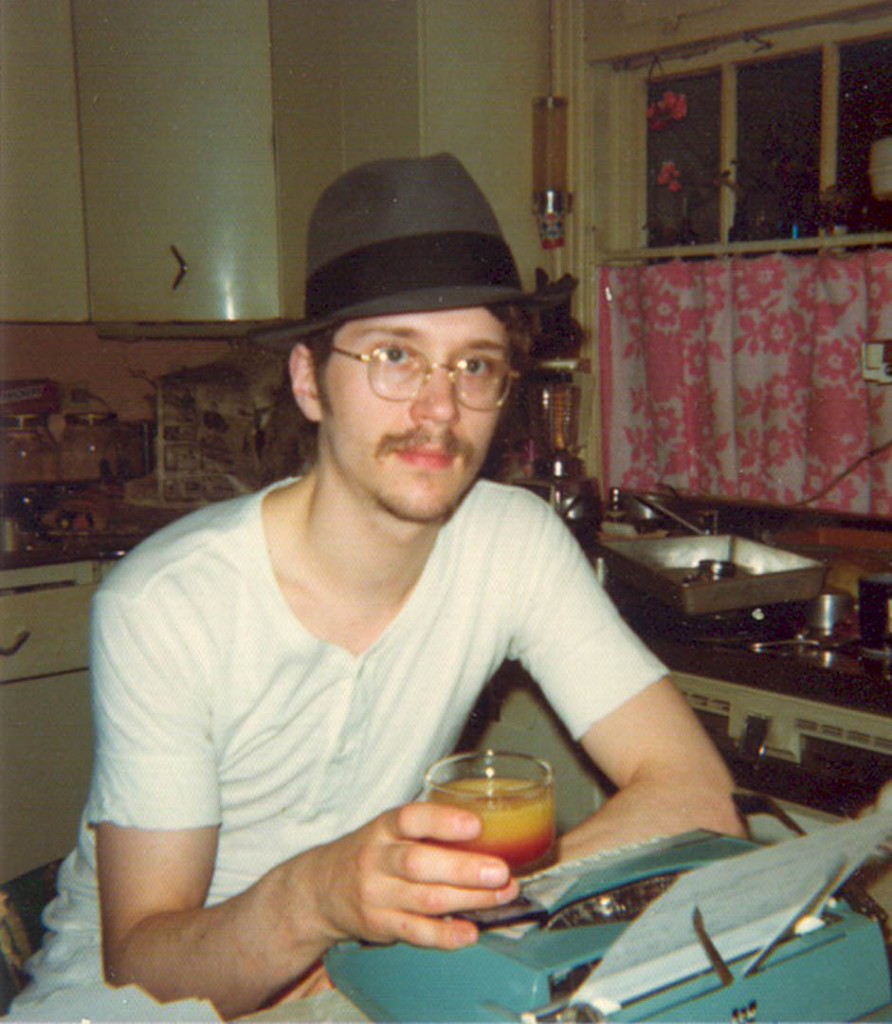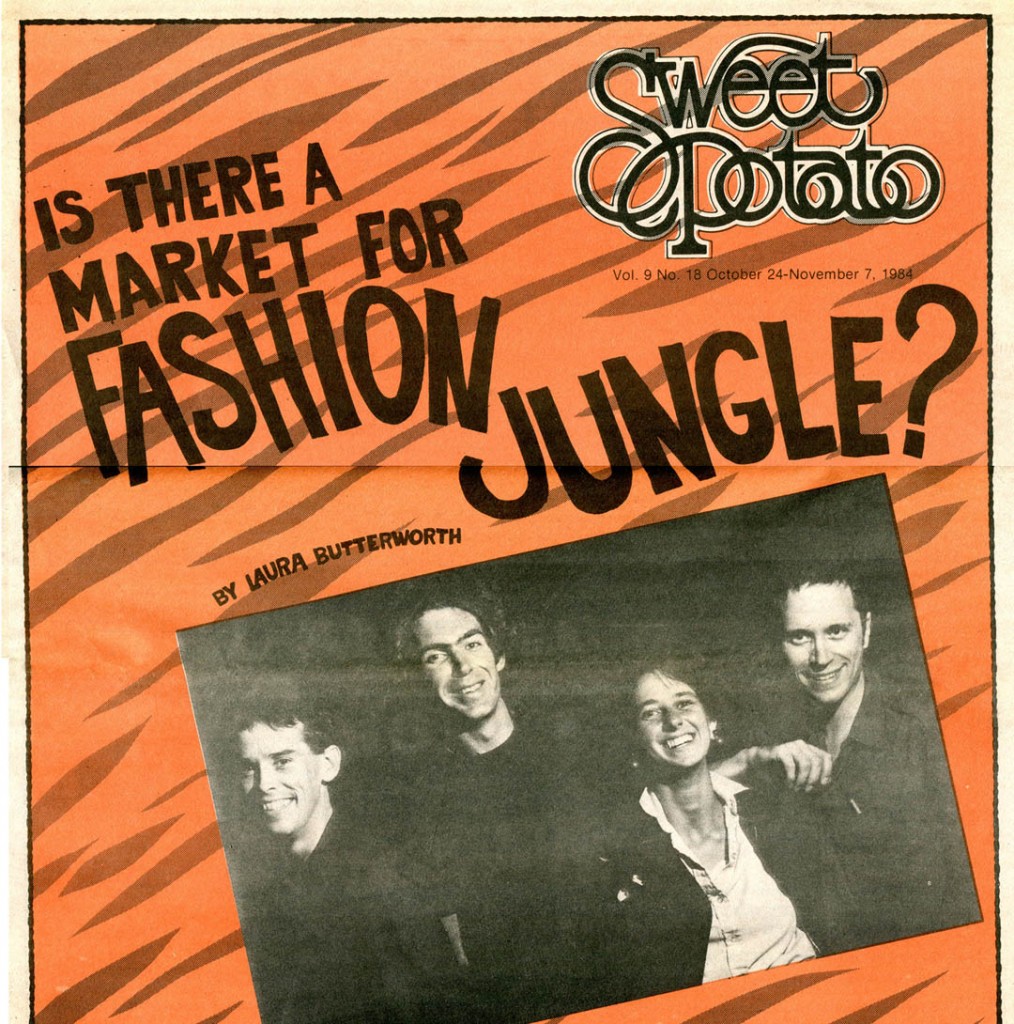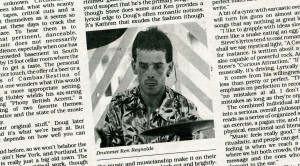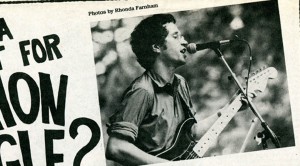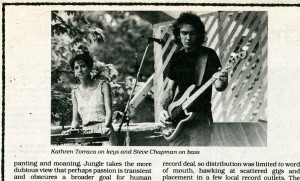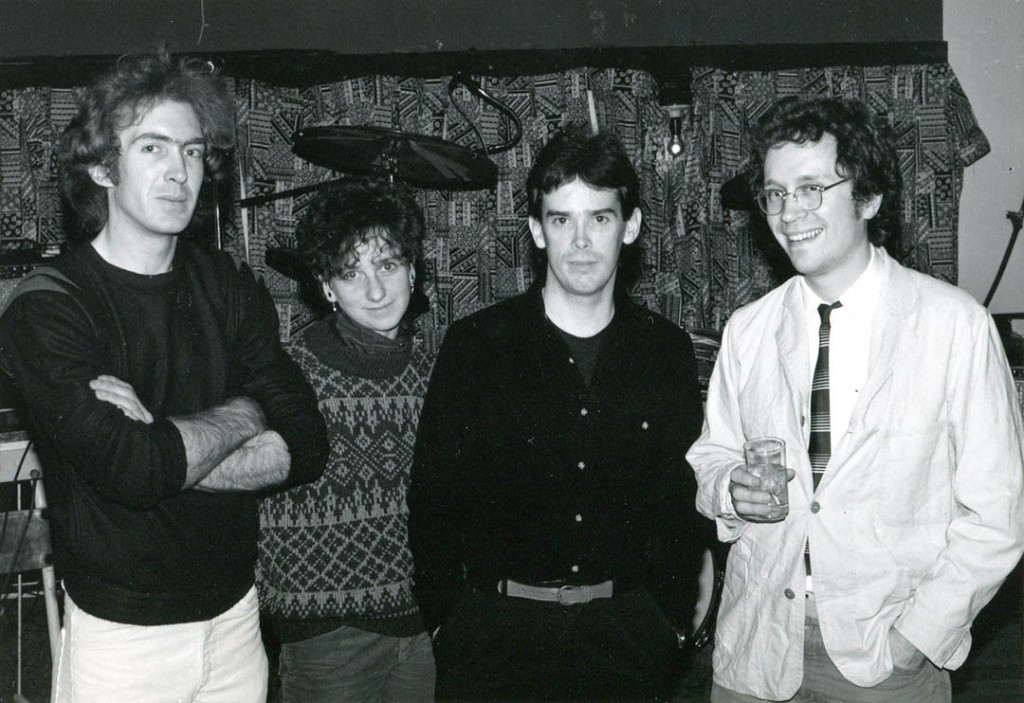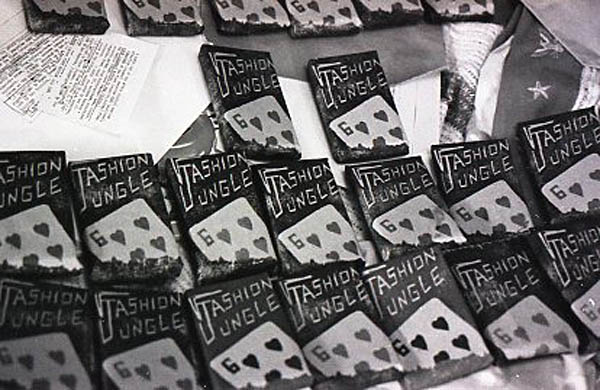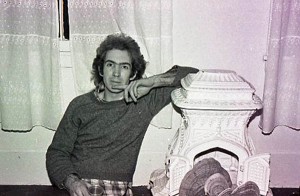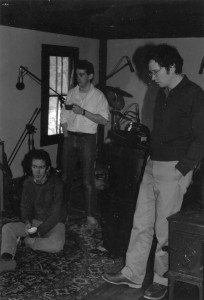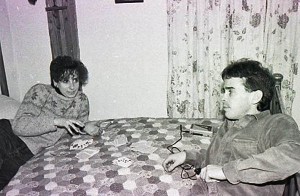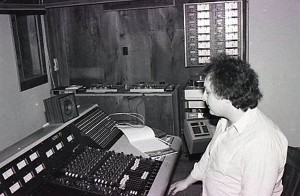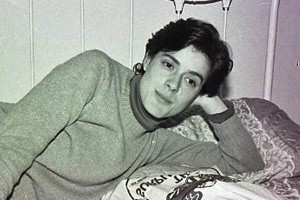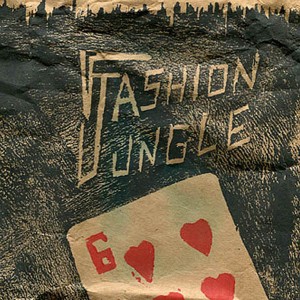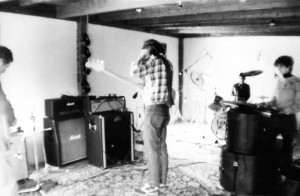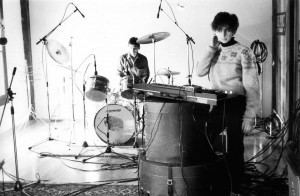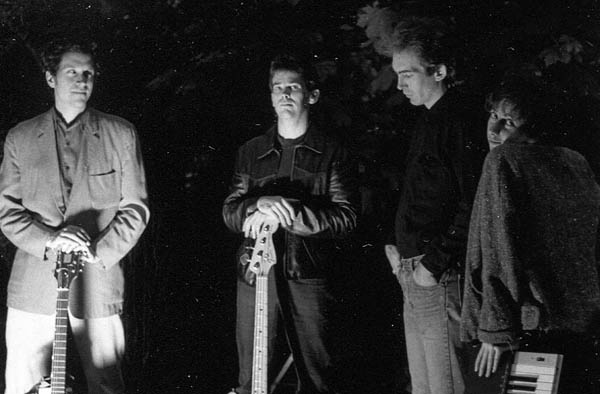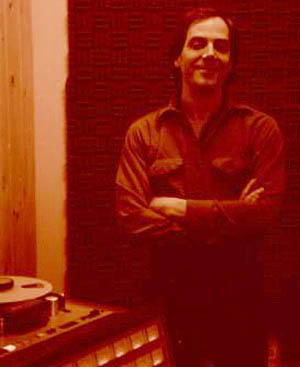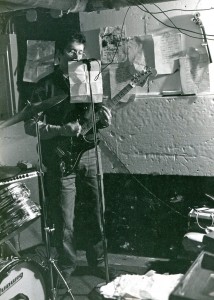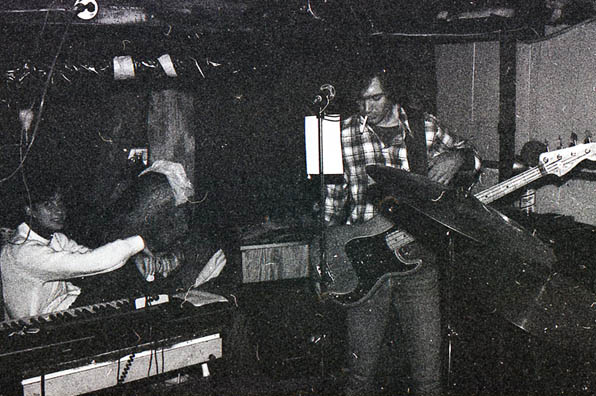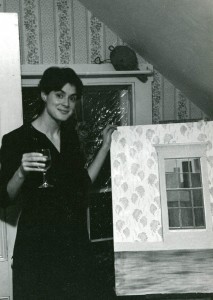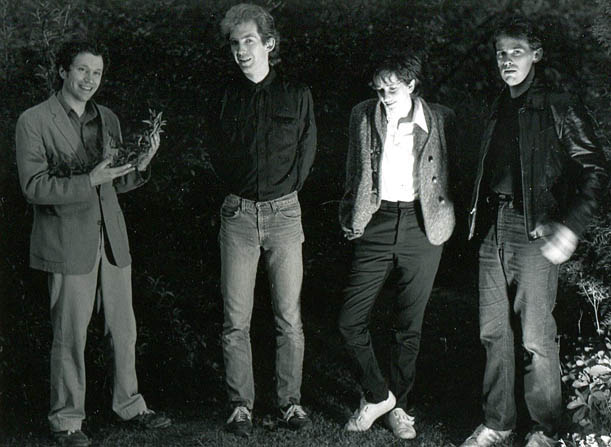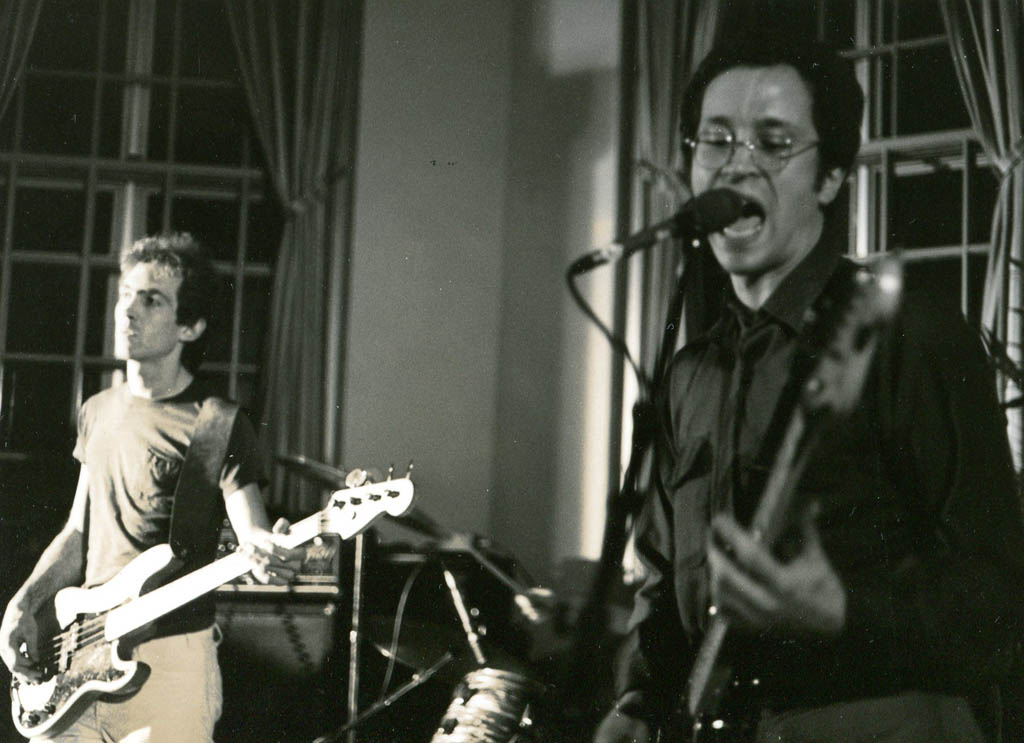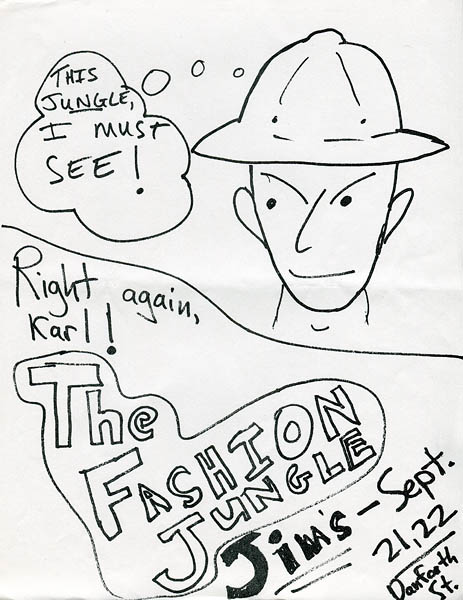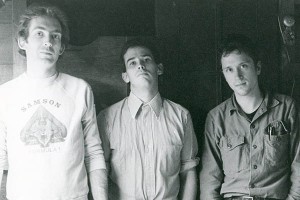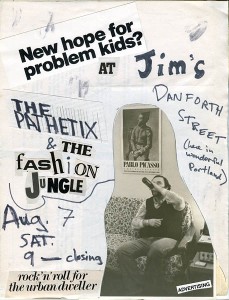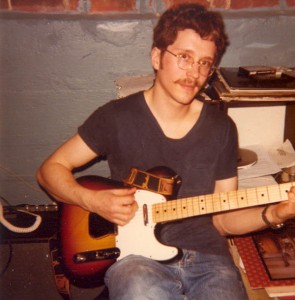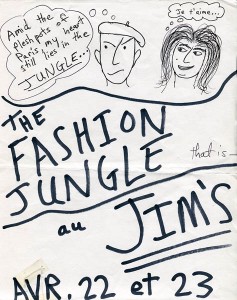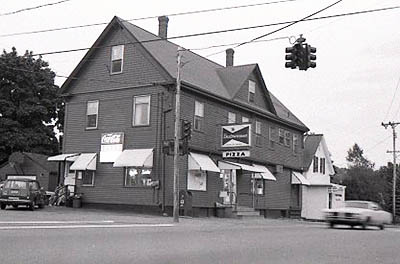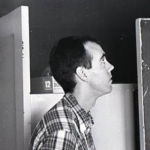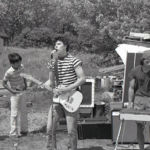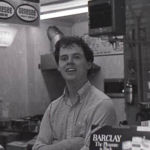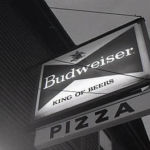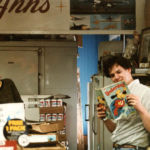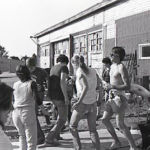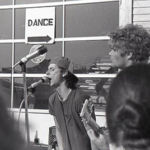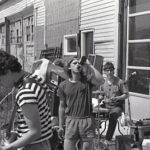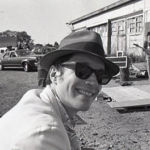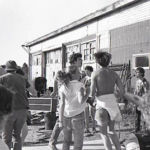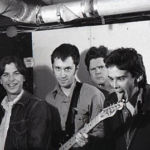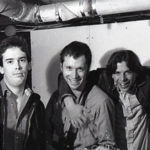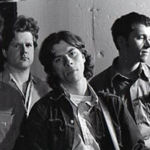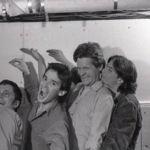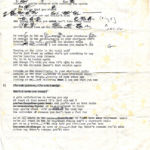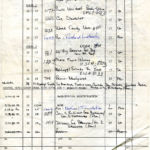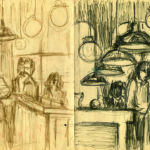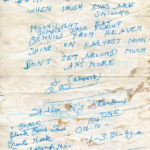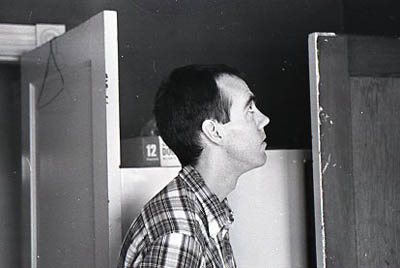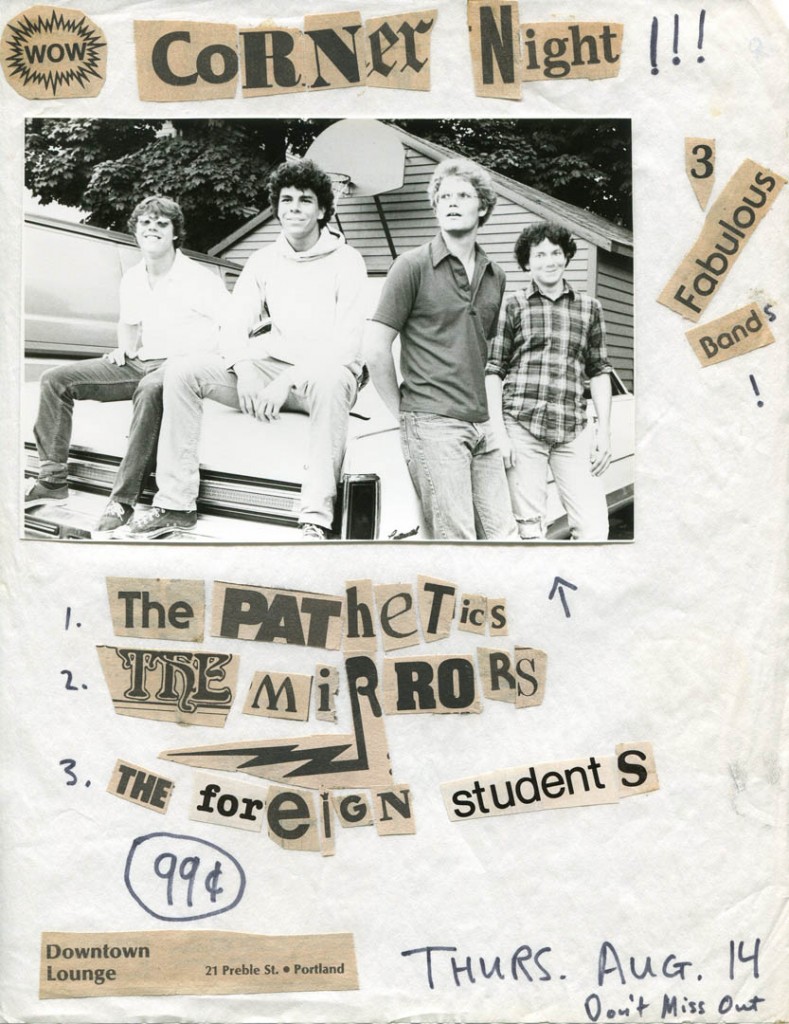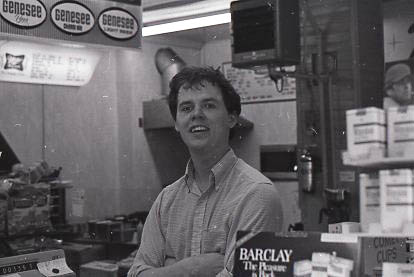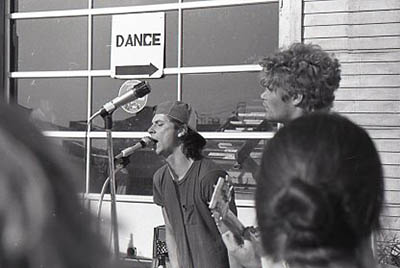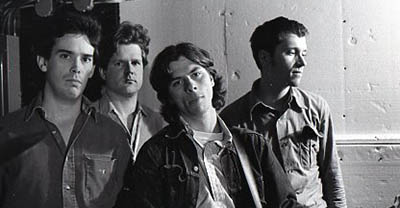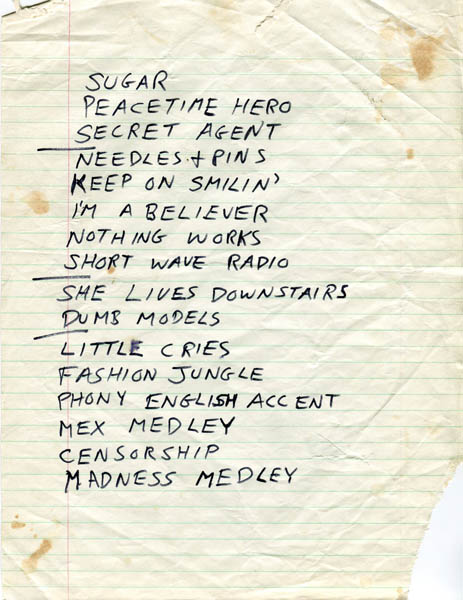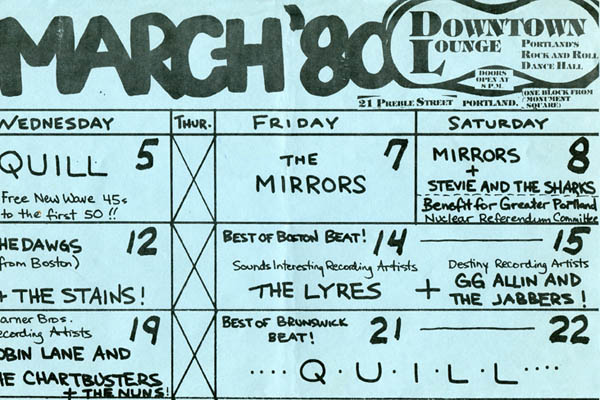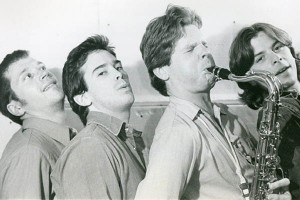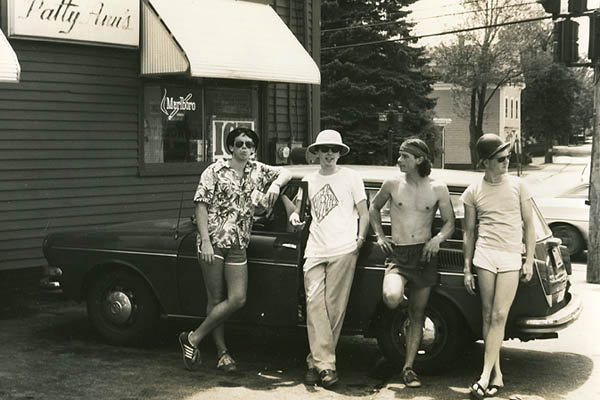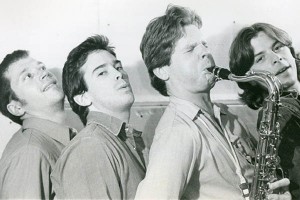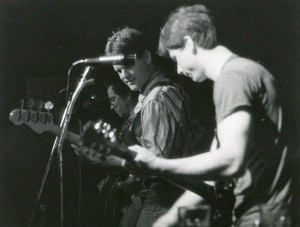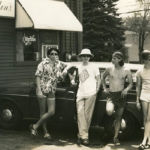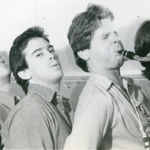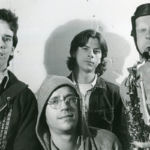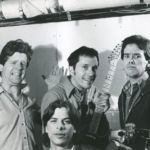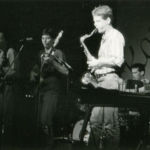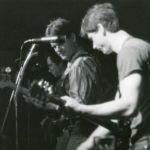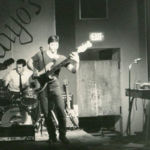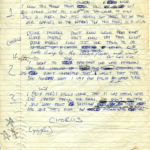Fashion Jungle: Knights and Free-lances
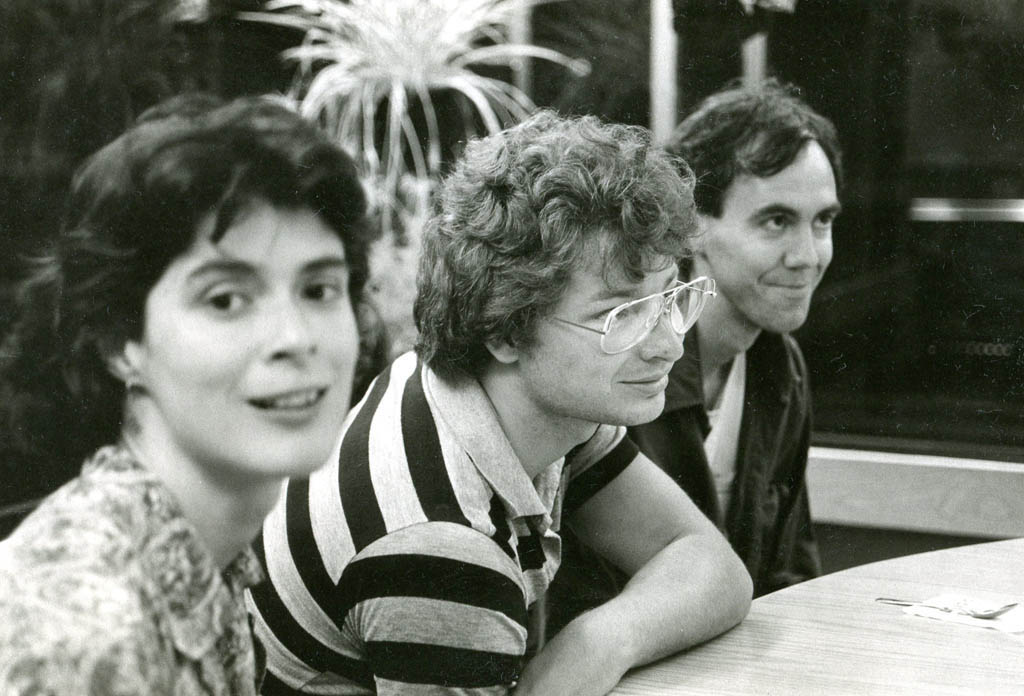
Gretchen Schaefer, Dan Knight and Jeff Stanton at Frosty’s doughnut shop, Brunswick, August 1985. We were in town to see a Maine Festival concert by Richard Thompson, who was wearing a pink suit that clashed quite splendidly with his red hair. Having interviewed him a few weeks earlier, I felt entitled to corner Thompson backstage and force a Fashion Jungle tape on him. Hubley Archives.
See two galleries of 1985 images:
Skip prolix verbiage! Go straight to Body Shop and swinging Fashion Jungle tunes!
Imagine a bloody hot attic apartment on a sunny afternoon, people crammed in under the dormers, champagne punch garnished with edible flowers frozen in ice (oh la), the mood garnished with kudos.
It was a party marking the beginning of my (first) career as a freelance writer and editor. My girlfriend, Gretchen Schaefer, now my wife, graciously hosted the event in her tiny apartment near Willard Beach in South Portland, Maine. As Ray Davies sang, all of my friends were there. It was June 1, 1985.
What a blast. Much of it is a blur but I have a vivid memory of Gretchen, me and Jeff Stanton, our good friend then and now, standing at water’s edge at Willard after the others had left, swaying happily in an alcoholic breeze as the waves caressed the sand and the sun sank low.
‘Creative renaissance’
That moment seems to symbolize that time in life for Gretchen and me. There are several half-baked concepts that my mind can’t shake off, and one of them is the “creative renaissance”: a rare and miraculous flowering of creative energy. The mid- to late 1980s was such a time for us. After four years together, for us 1985 was the year when our interests and ambitions seemed to begin to bear fruit.
For two years I had worked full time in the library at the Guy Gannett newspapers in Portland, but at the same time I was writing arts and entertainment stories for those papers on the side. That work was much more fulfilling — and the pace was picking up, to the extent that it was a challenge to work writing assignments in around the library job.
When Gannett put out a call for occasional copy editors, work that appealed to me and paid well, I saw my ticket out of the library and its endless routine of clipping, filing, retrieving and refiling news stories. Between copy desk shifts and writing, I figured I could make a decent living doing work I liked.
For a few years, that’s how it worked out. But the real benefit was over the long haul, as the journalistic and editorial experience I gained in the second half of the 1980s continues to stand me in good stead even now.
Gretchen, meanwhile, was painting and making prints as intensively as she could, given the constraints of her job at a high-end photo processor and of that cramped attic apartment.
And in fact, in a June when auspicious events seemed to fall into place like tumblers in a combination lock, she became manager of an art gallery on Congress Street. If this was not quite fulfillment for an artist, it was motion in the right direction and valuable exposure to the business of art.
So in this Year of the Creative Renaissance, our lives were largely about creative work: making our own, contemplating others’, talking about it all. On June 8, over bourbon and Coke, Gretchen and I hatched the idea of the Visible Gallery: a gallery / open studio / performance room where, of course, fulfillment would reside with us and money would come in with the tide. We called it the Visible Gallery because of the open-studio idea: like the anatomical toys of the 1960s, all the guts would be on display.
“I think we’re serious about it,” I wrote in my journal. And so we were, as events a couple months later would demonstrate. (Read a full journal entry.)
Knight comes in
The cherry on this sundae of bohemian fantasy-made-real, for me at least, was that my band, the Fashion Jungle, was back in business after a winter and spring dedicated to declaring it over and done with. (Read more about the rise and fall of the 1983–84 FJ.)
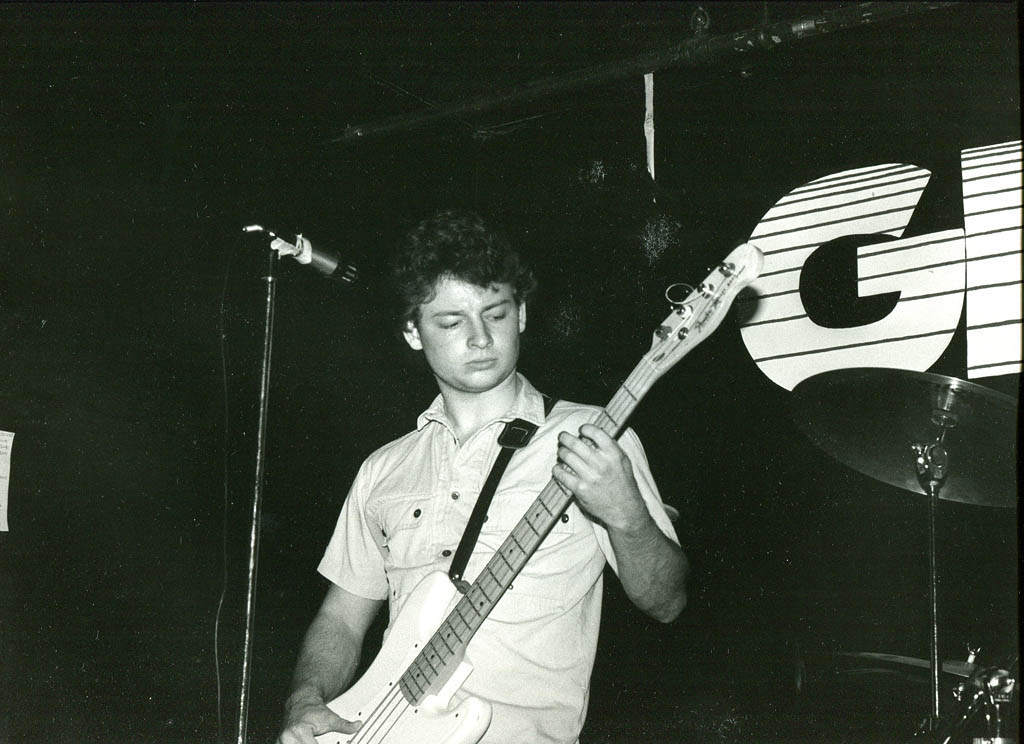
Bassist Dan Knight during a 1985 Fashion Jungle performance at Geno’s, Brown Street, Portland. Jeff Stanton photo.
We all took a turn calling it quits, but the decisive blow came when drummer Ken Reynolds was hired full-time at the post office, working six evenings a week. Ken and I had played together for eight years, and the propect of breaking in a new drummer seemed insurmountable.
But in March 1985, just a month after that development, Ken switched from second to third shift, and was once again able (and willing) to rehearse.
An ad in Sweet Potato produced Dan Knight, a young University of Southern Maine student who was friendly, earnest and a good player conversant with an impressive variety of music. We took him on in early July — and promptly accepted a July 27 booking, back at Geno’s.
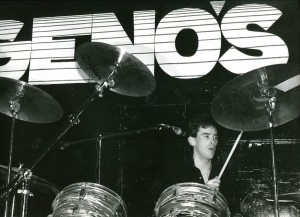
Hmmm, I wonder where this was taken . . . Ken Reynolds during a 1985 Fashion Jungle performance at Geno’s, Brown Street, Portland. Jeff Stanton photo.
Dan absorbed the FJ material quickly, no mean feat considering its complexity. Like that of Steve Chapman, his predecessor, Dan’s playing was fluent, but it was much more reflective of the bass vernacular. Steve’s playing was big, romantic and in a style unto itself. In Dan, you could hear decades of roots music and pop radio, organized with witty energy into a burbling, driving stream.
It’s a question how much of Dan’s style was driven by his equipment. It’s possible that he needed to play a lot of notes because, as a student, he couldn’t afford the gear to get a more sustaining sound. He used a succession of inexpensive basses, including my Hagstrom, a flatulent device with whimsical intonation; and I don’t think he ever got a bass amp powerful enough to stand up to the FJ decibel level.
Our run with Dan was only six months, and I regret it wasn’t longer, because we made a start at a new Fashion Jungle sound — raw, driving, and more like rock than the previous band’s “New Wave” — that was promising. (Hear the recordings below.)
We played a bunch of times, including three dates at Geno’s and the wedding of Ken’s friend Doug Czerwonka, held at the Lost Valley ski resort in Auburn in October. We learned a bunch of totally unlikely songs for that job, from “My Girl” to “Get Off My Cloud” to “Una Paloma Blanca” to “Come Fly With Me” (awful) to Myron Floren’s “Fingertip Polka” — the start of a pesky polka obsession for me. Creative Renaissance!
Boozeness meetings
As hard as we were pursuing our creative pursuits, Gretchen and I were also putting more energy into our social lives, thanks to work schedules that accommodated late nights. Somewhere along the way we launched a series of Monday-night “boozeness meetings” — gatherings at Three-Dollar Dewey’s, in the original Fore Street location in Portland.
The idea of the boozeness meetings was that Monday night was the time and Dewey’s was the place, and whoever felt like going would go, in the hopes that someone else would go too. For several months, that’s the way it happened: In addition to G. and I, we could often expect to see Jeff, Ken, former FJ keyboardist Kathren Torraca, our friend Alden Bodwell, and friends of the various friends. We’d hang at Dewey’s, maybe play cards, and wind up with a late visit to the Woodford’s Café for an English mufffin.
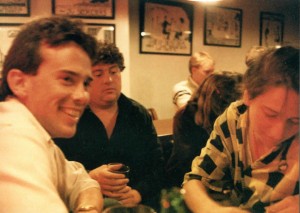
A Monday Night Boozeness meeting at Three Dollar Dewey’s, 1985. From left, Ken Reynolds, Chris Bruni, two unknown subjects, Kathren Torraca.
At the same time, our connection with our friends was strengthened by the fact that we got our own playhouse. Gretchen and I had pursued the Visible Gallery idea, and placed a “space wanted” ad in which I blathered on in wry / exalted terms about what we hoped to achieve. This amused a Mrs. Orlando (husband: Tony) who was willing to rent us half of a one-story industrial duplex at 178 Washington Ave.
It was perfect, a large open space accompanied by a bathroom and a small office. Good for painting, for rehearsals, for parties. The best part was the truck door: For a gig, Alden could drive his van right into the rehearsal space for loading and unloading.
I can’t recall, or don’t want to, how much arm-twisting we engaged in, but in August 1985 we rented the Washington Avenue space as a collective: the Fashion Jungle with Jeff and Gretchen. The last time I played music in my parents’ cellar was Aug. 28, 1985 — my diary notes that my mother seemed sad that rehearsals at 103 Richland St. were over, although I’m sure Dad was happy to lose the racket.
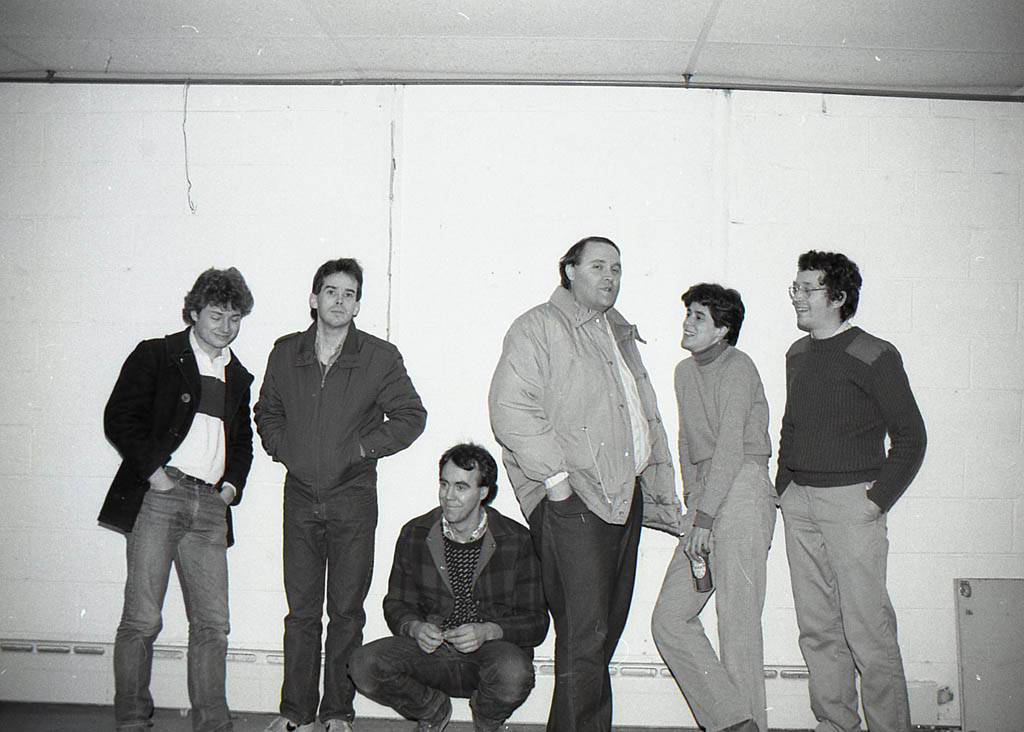
Last night at the Body Shop — the warehouse space on Washington Avenue that was our clubhouse for five months. From left: FJ bassist Dan Knight, drummer Ken Reynolds, roadie-photographer Jeff Stanton, roadie-driver Alden Bodwell, roadie-artist Gretchen Schaefer, guitarist-commando Doug Hubley. Photo by Minolta self-timer/Hubley Archives.
We moved in at the beginning of September. We had good times at the Body Shop, as we came to call it in honor of a previous tenant. Naturally, it became a social club as much as anything. In fact, over the course of the few gigs that the FJ played while we were based there, I at least perceived a real solidarity amongst the six of us who were at Washington Avenue, and at the gigs, the most: Alden, Dan, Doug, Gretchen, Jeff and Ken.
But problems soon became obvious with the Body Shop (we weren’t there long enough to bring the Visible Gallery to life). The biggest was that we simply couldn’t afford it. And despite our high ambitions, not everyone had a real use for the space. For Gretchen, who didn’t have a car, simply getting there on her own from South Portland involved two bus trips and a prohibitive amount of time.
By November, the money crunch was exigent (the rent party was fun, but didn’t help the situation much). By December, Ken had given notice, muttering about going to California to work for the Defense Logistics Agency. Through January, we tried to record all of our material, not succeeding. On Jan. 27, 1986, at Geno’s, we played what was billed as the Fashion Jungle’s last gig.
Of course, it wasn’t. But it was the last time I set foot on a stage in 1986.
Hear studio recordings by the 1985 Fashion Jungle: We spent our last month at the Body Shop attempting to record our repertoire for posterity. It had been a problematic space for recording because of a commercial radio signal that leaked onto the tape, but somehow we dodged that bullet for these sessions. Dan Knight, bass and vocal (“Blood From a Stone”). Ken Reynolds, drums. Doug Hubley, guitar and vocals. Recorded at the Body Shop on the Sony TC-540.
- Phony English Accent (Hubley) Bitchy and self-righteous enough that I regret it now (but not enough to withhold it), this standard from the original Fashion Jungle was my response to the posturing that had infected American punk and New Wave by the early 1980s. Hear an earlier version.
- Why This Passion (Hubley) The original version of this song written for the Fashion Jungle in 1983 was a rococo creation that could barely stand up under the weight of its arrangement. For the 1985 FJ, I streamlined and supercharged the setting, to better effect.
- Corner Night (Hubley) Unintelligible to anyone who wasn’t close to the 1970s-’80s social scene around Patty Ann’s Superette, in South Portland, these lyrics were written in 1981 about two concerts given by three bands with ties to that scene — the Foreign Students and the Pathetix, in addition to the FJ. I contrived the Costello-esque melody in 1985 for the reborn FJ. Hear an earlier version.
- Coke Street (Hubley) In the 1980s, Portland’s Old Port Exchange was the go-go ’80s writ large and embellished with seagulls. This country song with its odd lopsided rhythm was one of my rare attempts at social commentary. The lyrics absolutely do not hold up (“Love letters on an Apple II”?), but the music is cool. Hear an earlier version.
- Blood From a Stone (Knight) This Byrdsy number was bassist Dan Knight’s contribution to the Fashion Jungle catalog.
“Phony English Accent,” “Why This Passion,” “Corner Night” and “Coke Street” all copyright © 2010 by Douglas L. Hubley. “Blood From a Stone” copyright © 1985 by Daniel B. Knight. All rights reserved.
Text copyright © 2013 by Douglas L. Hubley. All rights reserved.





















